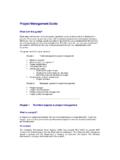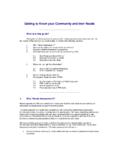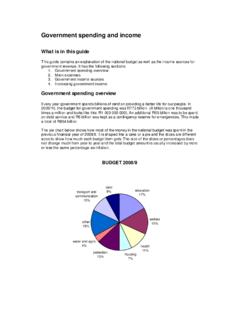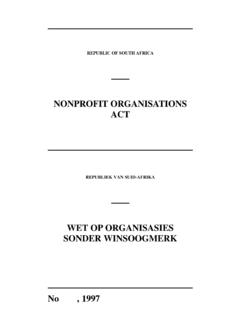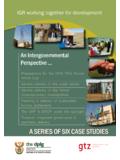Transcription of Important facts about HIV and AIDS - ETU
1 Important facts about HIV and AIDSHIV and AIDS is one of the biggest challenges we face as a country. The incidence of HIV is rising rapidly and over million people are already HIV-positive. Thousands of people are becoming ill and dying every week and more and more children are being orphaned. As more people have become ill, the impact of AIDS has been be felt in virtually every community. The research to measure how common HIV infection is in South Africa is done among pregnant women who visit state health clinics. The infection rates quoted below for each province are for those women. The national HIV infection rate among pregnant women attending antenatal services in 2010 was These statistics apply mostly to young women who are sexually active. Many of the men who are partners to these women will also be HIV positive.
2 Estimates are that these figures mean that about 20% of all South African adults are infected. The report showed that HIV prevalence among antenatal women was in 2010, compared with in 2009. The study was conducted among a sample of 32 225 first time antenatal care attendees last year, with 32 861 having participated in WHO/UNAIDS estimates the number of people living with HIV in SA for 2010 at million. Of these, 518 000 were children under 15 years, while were adult females over the age of study reflected that the peak in HIV prevalence (from 2007 2010) was now occurring in the 30 34 years age category, where of women tested were positive . The encouraging finding was the decline in the prevalence rate in the 15 24 years age group, which went from in 2001, to in infection rate amongst pregnant women was as follows in2006, 2008 and 2010 (The 2010 figures were released by the South African Department of Health in 2011)1 South Africa AIDS deaths estimates, end 2006 Source: Report National HIV and Syphilis Prevalence Survey, South Africa, the end of 2006 an estimated million people had died of AIDS-related illness in South Africa and more than 1 million children had become orphans as a result of AIDS.
3 Almost one thousand people die every day. Between 2006 and 2010 at least a million more people died of AIDS and the number of orphans now number around 2 expectancy, which was 60 years in 1990 had decreased and around 50% of people will not live to 60. Most of the people who are dying from AIDS are women between the ages of 18 and 40 and men between the ages of 30 and 50. This means that the most vulnerable groups are women of child-rearing and working age and men in their working years. This will badly affect our society as a whole. HIV and AIDS Strategic Plan for South Africa, 2012-2017In 2003 the South African government approved a Comprehensive National Plan on HIV and AIDS Care, Management and Treatment. This plan was evaluated and revised in 2006 and again in 2011. The 2012-2017 strategy has clear goals and targets to: Halve new HIV infections; Ensure that at least 80% of people who need treatment for HIV are receiving it.
4 At least 70% of these people should be alive and still on treatment after five years; Halve the number of new infections and deaths from TB; Ensure that a legal framework exists and is used to protect the rights of people living with HIV; and Halve the stigma related to HIV and government, however, faces a big challenge in meeting these goals and will need a great deal of cooperation from civil society and local communities. The strategy is based on the principles of partnership, effective leadership and good communication. It seeks to promote social change and to make sure that funding is available for key programmes. NSP PrinciplesThe NSP and related provincial implementation plans are guided by a set of principles. 1. Interventions must also have high impact and must be able to be rolled out to scale. 2. Plans will be based on evidence and experience, but at the same time they must be flexible enough to accommodate new research Plans must include all sectors involved in HIV, TBs and STIs: they must promote partnerships across sectors and at all levels of Africa has the third highest level of TB in the world, after India and China.
5 New infections increased by 400% over the past 15 years, reaching 970 new infections per 100,000 people in 2009. 2 Approximately 1% of the South African population develops TB disease every year. The HIV epidemic is driving the TB epidemic: more than 70% of patients are co-infected with both diseases. The highest prevalence of TB infection is among people in age group 30-39 years living in townships and informal settlements. This confirms the fact that TB is a disease that affects poorer communities of the NSPThe NSP has identified four strategic objectives to reach its five-year goals: These are: Address social and structural factors that influence the three diseases Change conditions and behaviours that fuel the twin epidemics of HIV and TB. This needs interventions across all sectors (not just health) that will reduce vulnerability to, and lessen the impacts of HIV and TB.
6 It includes things like poverty alleviation, improving service delivery and living conditions, keeping children in school, giving poor people better access to social grants and government services, de-stigmatising Aids and TB and making sure all government departments and municipalities mainstream responses to Aids. Prevent new HIV, TB and STI infections Make sure that everyone is tested for HIV and TB every year, and that people who need treatment receive it. Improve prevention of mother to child transmission, male circumcision rates and treatment and prevention of STI. Sustain health and wellness Ensure access to quality treatment, care and support services for those with HIV, STIs and/or TB. Support people to stay on treatment and develop programmes that focus on wellness. Improve community level primary health care, number of treatment centres and specialist referral for difficult cases.
7 Protect human rights of people living with HIV Work to end stigma, discrimination, human rights violations, and gender SANAC Monitoring and Evaluation unit will collect national information on an agreedset of subjects or indicators. This information will be gathered from a wide range ofagencies already engaged in this work, for example the Department of Health, the NationalHealth Laboratory Services and research AIDS and HIVAIDS means Acquired Immune Deficiency Syndrome. It is a disease that destroys your ability to fight other infections through your immune system. The immune system is your body s defence against disease your white blood cells attack and destroy many diseases. AIDS is caused by the - Human Immunodeficiency Virus, usually called who get HIV can stay healthy for many years and most infected people do not even know that they are HIV positive.
8 There are no visible signs to show that a 3person is infected. They can pass the disease on to other people by having unprotected sex with them (sex without a condom). AIDS moves through four different stagesIn stage one the person is HIV-positive but has no symptoms, except for some short-term flu-like symptoms which may occur within a few weeks of infection. This stage may last several years during which the person might have no HIV-related illnesses. In stage two the person begins to develop minor illnesses. Ear infections, frequent flu and skin problems are common at this stage three the person may lose a lot of weight and have longer term illnesses. These may include thrush in the mouth, pneumonia, a fever which lasts more than a month and tuberculosis of the lungs. In stage four, the person has illnesses due to a very weak immune system.
9 These may include PCP, pneumonia, chronic diarrhoea, toxoplasmosis and meningitis. It is at this stage that a person is said to have AIDS. A person is also said to have AIDS if their CD4 count (white blood cells) goes under itself does not kill people they usually die from other infections like the ones listed in stage four. Poor people tend to become ill and die much sooner than wealthier people. This is because of poor nourishment, bad living conditions and poorer health is HIV transmitted?There are only three ways to get HIV: sex (sex without a condom), between your blood and infected blood or body fluids, and to child Unprotected is the most common way that people get HIV. If you have sex with an HIV positive person and there is direct contact between the penis and vagina or anus, you can easily get infected.
10 The virus lives in the fluids inside the penis and vagina and can easily enter your bloodstream. Using condoms properly is the only protection against this kind of infection. (For information on the correct use of condoms see guide on support groups)You cannot get AIDS from kissing someone on the lips, hugging, sharing food and drink or using the same bath or toilet as someone who is HIV positive. (Deep kissing or French kissing can pass on HIV if you have sores in your mouth)2. Contact with infected If you have an open wound and it is exposed to the blood of an HIV positive person, you can be infected. This contact could be through using the same needles for drugs or unsafe instruments used for circumcision. It is possible to get HIV if you use the same razor blade or tooth brush as an HIV-positive person if there are any traces of blood on the implement.
